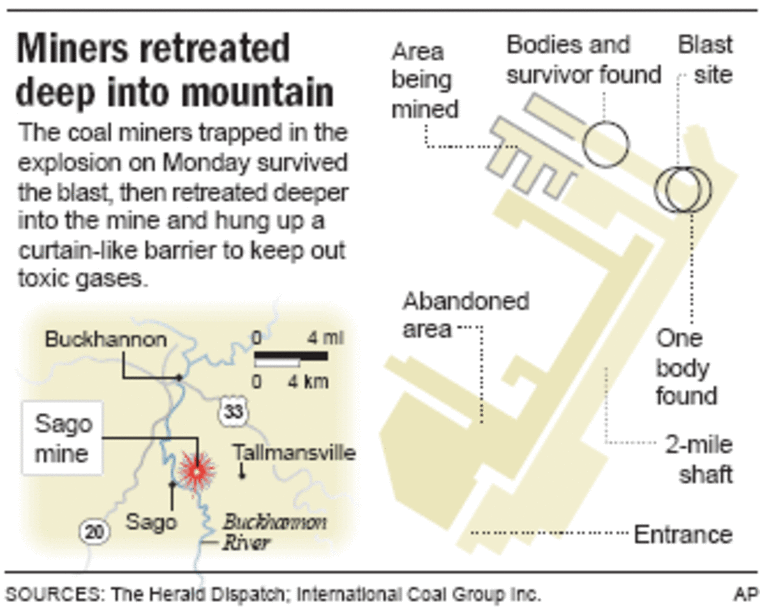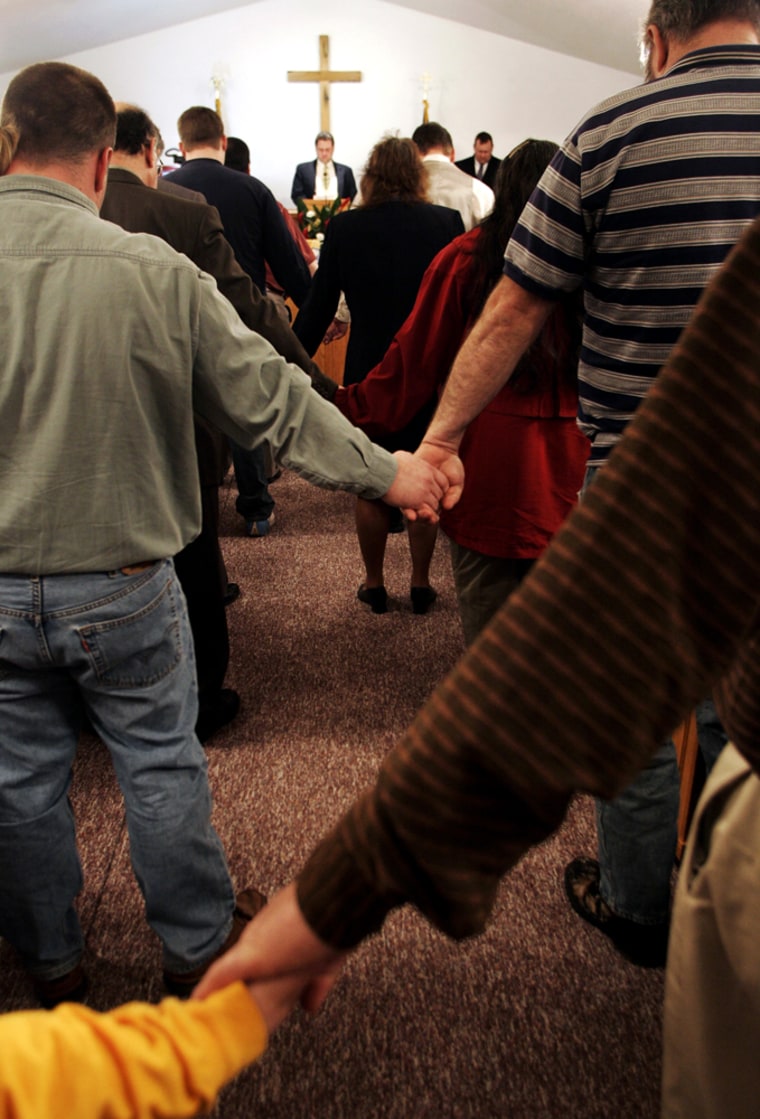Eleven miners who died in the Sago disaster could have walked out alive had they known that there was healthier air less than 2,000 feet away, the head of the mining company told NBC News in an interview aired on Monday — exactly a week to the day that the men sat trapped in the mine awaiting rescuers who arrived too late for all but one survivor.
“They were headed into an unknown,” International Coal Group CEO Ben Hatfield said. “They had no way of knowing how big, how disastrous the explosion was. In hindsight, if they had known that the smoke was only extremely dense in an area of perhaps 1,000 or 1,500 feet, yes they could have moved to fresh air, yes they could have survived, but they had no way of knowing that.”
“It’s over two miles to the outside and they no doubt would have been concerned that they can’t walk through two miles of smoke,” he added. “If they had known that it was only 1,500 or 2,000 feet of smoke certainly they could have come on out and yes they could have been saved.”
Hatfield called it a tragedy that was “unavoidable and horribly sad” because the miners, even though they had breathing devices, did exactly what they had been taught to do: hunker down and wait for rescuers.
Crews did not know the location of the miners while they awaited rescue and had no way to communicate with them.
The men appeared to have died after about 10 hours and the rescuers only arrived after about 40 hours. Eleven men died awaiting rescue, one died in the blast that caused the disaster and a 13th survived.
Gases being vented
The interview was aired as the work of uncovering why the miners died resumes in earnest Monday. Federal investigators were at the Sago Mine over the weekend, but no one will be allowed into the mine until carbon monoxide and other deadly gases are vented.

International Coal Group said in a statement that the mine’s fan was working and circulating air through the mine. A pair of ventilation holes have been completed, and the company was working on a pilot hole for a planned vent in the area of the mine where the explosion apparently occurred.
At a news conference Monday, Gov. Joe Manchin named J. Davitt McAteer, who oversaw the federal Mine Safety and Health Administration during the Clinton administration, to head a special investigation for his office and prepare recommendations on improving rescue, communications and safety.
“My goal is to make West Virginia the safest mining state in the county,” Manchin said.
Also Monday, West Virginia Sen. Robert C. Byrd said officials from the federal MSHA would be called before a Senate Appropriations Committee hearing before the end of the month to testify about its response to the disaster. Manchin said the federal agency would also take part in public hearings in West Virginia.
Three funerals on Monday
Like most of those held Sunday, Monday’s memorials were to be private gatherings, with the media asked not to intrude after the heartbreak of the miners’ deaths played out last week on live television.
The Groves family invited The Associated Press inside miner Jerry Groves' memorial service, because his family wanted the whole world to “see our tears and our smiles,” said Mike Rose, Groves’ son-in-law.
“I know I’ll see him again,” Debbie Groves said, surrounded by friends and family at the Cleveland Independent Baptist Church for his funeral. “Eternity is forever. Our time here is just a vapor.”
ICG said in a statement that it is paying for all of the miners’ funeral expenses, but that Hatfield is not attending the services to avoid creating additional stress on the families.
“We’ve got people all over the world praying for us, and that’s how I’m getting by,” he said, sparking a chorus of “Amens” from the crowd, which listened to stories about the 56-year-old who spent half his life working in the coal mines.
Groves’ niece, Teresa Cogar, said her Uncle Jerry was “always sitting on his porch in his flip-flops, drinking an iced tea.”
A survivor clings to life
The surviving miner, 26-year-old Randal McCloy Jr., remained hospitalized in Morgantown. He had been in a medically induced coma to allow his brain time to heal, and while hospital officials said in a statement Sunday that his sedation had been stopped, they said it would take awhile for the medication to clear his system.
Then testing can begin to determine the extent of the damage McCloy suffered in the mine.
Dr. Larry Roberts, the head of McCloy’s treatment team at West Virginia University’s Ruby Memorial Hospital, said McCloy had shown signs of improvement since Saturday but remained in critical condition.
McCloy’s wife, Anna, asked that attention focus on those whose lives were to be remembered.
“We are thinking of them today and throughout this difficult time and we ask you to please keep all the families in your thoughts and prayers,” she said.
Near the end of Groves’ service, Rose asked all the coal miners in the crowd to stand and be recognized. To the 10 who stood, Rose said, “You are the backbone of this state and this country. Always hold your head high and tell everyone you’re a coal miner.”
He then ended the service with the same words Jerry always used to bid his family farewell.
“I’ll see you in a little bit.”
